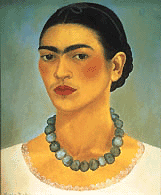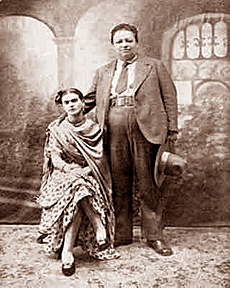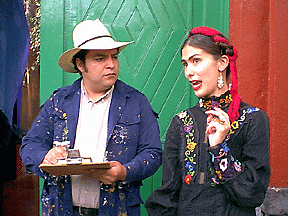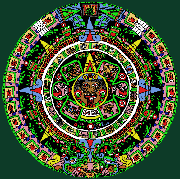FRIDA KAHLO
LIVES ON
by Bob Brooke
 Mourners gathered on July 13, 1954 to
watch the cremation of the world's greatest and most shocking painter.
Soon to be an international icon, Frida Kahlo knew how to give her fans
one last frightening goodbye. As the cries of her admirers filled the
room, the sudden blast of heat from the open incinerator doors blew her
body bolt upright. Her hair, now on fire from the flames, blazed around
her head like a halo. Frida's lips appeared to break into a seductive
grin just as the doors closed shut. Her last diary entry read "I
hope the leaving is joyful and I hope never to return". Though
Frida was only 47 on the day she died, she lives forever in her amazing,
and many times bloody self-portrait paintings and now in a hit movie,
"Frida.."
Mourners gathered on July 13, 1954 to
watch the cremation of the world's greatest and most shocking painter.
Soon to be an international icon, Frida Kahlo knew how to give her fans
one last frightening goodbye. As the cries of her admirers filled the
room, the sudden blast of heat from the open incinerator doors blew her
body bolt upright. Her hair, now on fire from the flames, blazed around
her head like a halo. Frida's lips appeared to break into a seductive
grin just as the doors closed shut. Her last diary entry read "I
hope the leaving is joyful and I hope never to return". Though
Frida was only 47 on the day she died, she lives forever in her amazing,
and many times bloody self-portrait paintings and now in a hit movie,
"Frida.."
Frida's life began and ended in Mexico
City, in her home known as Casa Azul, the Blue House, in the district
known as Coyocan. She gave her birth date as July 7,1910, but her birth
certificate shows July 6,1907. But Frida constantly lied about her life.
At age 6, polio struck her, causing her
right leg to appear thinner than her left. Upon entering the National
Preparatory School in Mexico City, she became a tomboy full of mischief
and the ringleader of a rebellious group of mainly boys that continually
caused trouble in school. They pulled many pranks on professors. It was
here that Frida first came in contact with her future husband, the
famous Mexican muralist Diego Rivera, who had been commissioned to paint
a mural in the school's auditorium.
The Accident
On September 17, 1925, at about age 18, a bus in which Kahlo was a
passenger collided with a streetcar, leaving her impaled on the
streetcar’s handrail. She suffered a broken spinal column, a broken
collarbone, broken ribs, a broken pelvis, 11 fractures in her right leg,
a dislocated and crushed right foot, and her shoulder out of joint. For
a month, she lay flat on her back, encased in a plaster cast and
enclosed in a boxlike structure.
Frida's enormous strength and will to
live allowed her to survive and make a remarkable recovery. She began
painting shortly after the accident because she was bored in bed. This
became her lifelong profession.
But she had many relapses of tremendous
pain and fatigue all throughout her life, causing her to be hospitalized
for long periods of time, bedridden at times, and to undergo numerous
operations. She once joked that she held the record for the most
operations–she underwent about 30 in her lifetime. She also turned to
alcohol, drugs, and cigarettes to ease the pain of her physical
suffering. "I drank to drown my pain, but the damned pain learned
how to swim, and now I am overwhelmed by this decent and good
behavior," she wrote in her diary.
Once she was out and about after her
accident, a close friend introduced Frida to the artistic crowd of
Mexico, including Tina Modotti, a well known photographer, actress, and
communist, and Diego Rivera.
 Diego Rivera eventually married Frida on
August 21,1929. As famous as the Mexico City murals made Rivera, his
star-crossed romance with Frida Kahlo drew him into a living tableau
that for much of the world has symbolized the 20th-century Mexican art
milieu seemingly for all eternity. Nearly overnight they became a
charismatic, celebrated couple on the art and society circuit around
Mexico, the United States, and Europe. Their marriage consisted of love,
affairs with other people, creative bonding, hate, and a divorce in 1940
that lasted only for one year. Their marriage has been called the union
between an elephant and a dove, because Diego was huge and very fat, and
Frida was petit and slender. Diego Rivera eventually married Frida on
August 21,1929. As famous as the Mexico City murals made Rivera, his
star-crossed romance with Frida Kahlo drew him into a living tableau
that for much of the world has symbolized the 20th-century Mexican art
milieu seemingly for all eternity. Nearly overnight they became a
charismatic, celebrated couple on the art and society circuit around
Mexico, the United States, and Europe. Their marriage consisted of love,
affairs with other people, creative bonding, hate, and a divorce in 1940
that lasted only for one year. Their marriage has been called the union
between an elephant and a dove, because Diego was huge and very fat, and
Frida was petit and slender.
Their tumultuous relationship and
Rivera's notorious infidelity–once with Frida’s own sister–only
seemed to propel their mythic status. "I have suffered two
accidents in my life," Kahlo is quoted as saying in the Malka
Drucker biography, Frida Kahlo: Torment and Triumph in Her Life and
Art. "One in which a streetcar ran over me. The other is
Diego."
Despite Diego's affairs with other women,
he encouraged Frida by suggesting she wear traditional, colorful Mexican
dresses and exotic jewelry. This, along with Frida's thick, connecting
eyebrows, became her trademark. He loved her work and was her greatest
admirer. Frida, in turn, was Diego's most trusted critic, and the love
of his life.
Frida let out all of her emotions on
canvas. She painted her anger and hurt over her stormy marriage, the
painful miscarriages, and the physical suffering she underwent because
of the accident.
The aftermath of the streetcar accident,
which included 28 plaster corsets designed to support her damaged spine,
forms a recurring theme in Kahlo's famous self portraits. But more than
the sometimes tortuously clinical details in these autoretralos,
it's her iconic facial features-the batwing eyebrows, the stern,
rose-like mouth, and secretive, sidelong glance fixed on the viewer-that
one most remembers. A pronounced sexual ambiguity is also often present.
In one portrait she suggests androgyny by merging her face with Diego's
while another portrays Kahlo sporting shorn hair and a man's suit and
tie. In a now-famous family photo from 1926 her hair is pulled back
tightly, and she again is dressed like a man.
Kahlo's Self-Portraits
Frida Kahlo’s self-portraits compel the viewer to look into her soul.
While her physical features and elaborate costumes are striking, it’s
her interior life that seems to explode beyond the canvas: as the
Surrealist writer André Breton once remarked, "The art of Frida
Kahlo is a ribbon around a bomb." Combining the familiar with the
strange, marrying naturalistic depiction with bizarre symbolism, Kahlo
invented a singular surrealistic portrait style that cuts straight to
the heart of deeply felt passions and sorrows.
"I paint my own reality," she
once said. "The only thing I know is that I paint because I need
to, and I paint whatever passes through my head without any other
consideration."
Frida, despite all of the hurt in her
life, was an outgoing person whose vocabulary resonated with four-letter
words. She loved drinking tequila, singing off-color songs, telling
dirty jokes, and shocking the guests at her crazy parties. She amazed
people with her beauty and everywhere she went, people stopped in their
tracks to stare in wonder. Men were fascinated with her, and because of
this Frida had numerous, scandal-filled affairs.
One affair was with Communist leader Leon
Trotsky. It began when he was a guest at her home along with his wife
soon after their arrival in Mexico. Later arrested for his murder, she
was let go. Several years after Trotsky's death, Diego and Frida enjoyed
telling people that they invited him to Mexico just to get him killed,
but no one knows if they were telling the truth or not. They were
fantastic story tellers.
Frida also had a bisexual side and had
affairs with many women, including painter Georgia O’Keefe and black
singer
All over the world, people loved Frida.
When she went to France, Picasso wined and dined her, and she appeared
on the cover of the French Vogue. In America, people loved her beauty
and her work. In Mexico, her homeland, she had many great admirers.
Frida only had one exhibition in Mexico
in the Spring of 1953. Her health had deteriorated and her doctor told
her not to attend. Minutes after guests arrived at the gallery, sirens
blared outside. The crowd went crazy as an ambulance accompanied by a
motorcycle escort pulled up in front of the gallery. The attendants
carried Frida Kahlo into her exhibition on a hospital stretcher and
placed her in her bed in the middle of the gallery. The mob of people
went to greet her. Frida told jokes, entertained the crowd, sang, and
drank the whole evening. And the exhibition was a huge success. Frida
told reporters, "I am not sick. I am broken. But I am happy as long
as I can paint."
During the same year as her exhibition,
Frida had to have her right leg amputated below the knee due to a
gangrene infection. This caused her to become deeply depressed and
suicidal, thus her life ground down to its eventual end.
Two Museums
 Today, two notable museums in Mexico City offer a look into Kahlo’s
bizarre life. Her family’s traditional courtyard-style, adobe
residence and her birthplace, known as Casa Azul, located at Calle
Londres #247, became her home and studio, and after her death, a museum.
For 25 years, she shared it with Rivera.
Today, two notable museums in Mexico City offer a look into Kahlo’s
bizarre life. Her family’s traditional courtyard-style, adobe
residence and her birthplace, known as Casa Azul, located at Calle
Londres #247, became her home and studio, and after her death, a museum.
For 25 years, she shared it with Rivera.
The house, built by her father, Guillermo
Kahlo, a German-Jewish photographer, is an explosion of color,
especially the cobalt blue and red-trimmed exterior. The interior is
preserved much as it appeared when Kahlo lived there. A four-poster bed,
in which she was born and died, stands in the bedroom. Calaveras,
or papier maché skeletons, and carved death masks are reminders of the
suffering she endured in her daily life and which fueled her creativity.
About 50 of the self-taught artist’s
works are on display, including some surrealistic self-portraits
reflecting an obsession with health problems that plagued her most of
her life. A large Mayan urn behind glass contains her ashes.
Her spacious studio remains essentially
as she left it. Her wheelchair, paintbrushes and an easel on which rests
an unfinished portrait of Joseph Stalin, seem to await her return.
Displays of wooden spoons and ceramic
jugs and bowls hang on the walls and sit on the counters of the brightly
tiled kitchen. Also displayed is an arrangement of miniature retablos,
small devotional paintings on tin, a sampling of Rivera’s drawings and
murals, photographs, love letters, an address book and other personal
effects, as well as a collection of pre-Hispanic poetry and ceramic
figures. Occasionally, a group of young actors play Diego and Frida to
the delight of museum visitors.
Frida and Diego also built two separate
houses with studios for each of them in the San Angel district of Mexico
City just after their marriage in 1929. Now known collectively as the
Diego Rivera and Frida Kahlo Studio-House Museum, it’s considered by
many to be the first example of avante-garde architecture in Mexico.
Artist Juan O’Gorman, a long-time
friend of Rivera’s, designed both three-story houses in the Bauhaus
style using the ideas expressed by architect Le Courbusier. A
second-story, outdoor walkway connects Frida’s house, now painted
cobalt blue, to Rivera's, creating separate spaces for each artist,
illustrating the independence the couple maintained throughout their
caring but unconventional union. Here, Kahlo and Rivera entertained the
elite of the art world. One of their more famous houseguests was film
star Edward G. Robinson, who bought four of Kahlo’s paintings for $200
each, at the time Kahlo's most substantial sale.
Her Tragic End
Clearly Frida was a woman who let nothing stand in her way. No
matter how painful things could become for her, she stood tall, facing
all obstacles with a sense of style and strength. She was an extremely
sexy and talented woman with a theatrical and electrifying personality,
who had a love for art and life.
On July 13, 1954, Frida died. No official
autopsy was done. Suicide was rumored. Her last words in her diary read,
"I hope the leaving is joyful and I hope never to return."
What she doesn’t know is that her spirit has returned in one of the
most remarkable movies about Mexico and Mexicans ever produced. |

